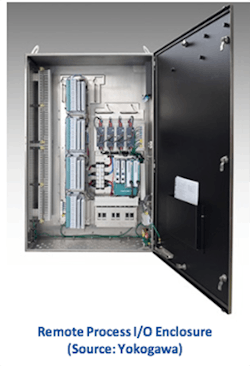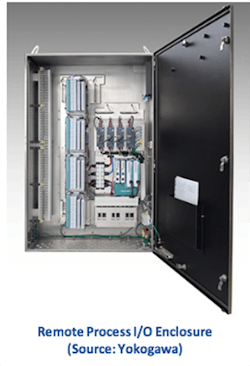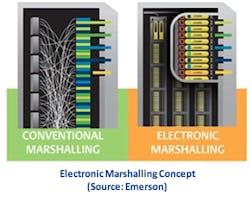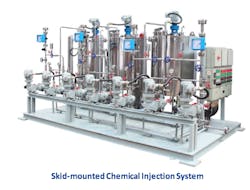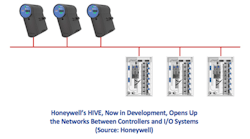Major trends in the architecture of distributed control systems (DCS) are not adopted overnight. At present, ARC Advisory Group is following several ongoing trends in DCS. These range from highly mature ones such as remote I/O enclosures to newly emerging trends such as the virtualization of control functionality.
Different DCS suppliers will be at different stages in adopting these trends in their own product lines. However, looking over the entire market, we see several key trends that build on each other. Several others are now barely visible but should become quite important in the market over the next three to five years.
I/O Capabilities And Virtualization Are Major Drivers
Overall, these trends are driven by very few factors. One factor is the growing capability of remote I/O and enclosures. These have evolved from simple field junction boxes to complete control systems. Another technological driver is growing use of virtualization in different areas of DCS products and markets.
In all these cases, the reason for adoption is greater business value. This can be achieved by reducing material and labor costs and complexity during a capital project, compressing a project schedule, and providing improved levels of manageability and cybersecurity for the installed life of an automation system. Here, ARC presents these major DCS trends, from the most mature to the newly emerging. But be aware that the development and adoption of these trends contains significant overlap.
Remote I/O Enclosures
Process I/O equipment for early DCS products was located in unit control rooms or rack rooms with well-controlled environmental conditions (temperature, humidity, particulates, etc.). As more hardened I/O systems were developed, suppliers began to move I/O equipment into the field (closer to the field transmitters, valves, etc.). Remote I/O enclosures were networked to the physical controllers using high-speed redundant networks, typically dual fiber optic Ethernet that could support the long cable runs sometimes necessary.
This trend is already deeply established in the market. The business value comes through lower installed costs via reduced cabling requirements and complexity. Older designs required I/O signals to be first landed at field junction boxes and then wired to the control area using multi-conductor shielded cable. Both the material and labor cost of this traditional design are significant, as is the engineering complexity. The only opposition to the remote I/O enclosure trend is where environments are so extreme that even the most hardened electronic equipment cannot function reliably. Save for those environments, the use of remote I/O enclosures in distributed control systems is now a given.
Virtualization Of Human-Machine Interfaces (HMI)
Virtualization of HMIs, another trend now commonplace on greenfield projects, is increasingly penetrating the installed base of DCS. Operator interfaces for the DCS once consisted of multiple physical PCs. These tended to have a relatively short product lifecycle due to the high rate of technology churn in the PC market. Manufacturers operating earlier DCS products found themselves forced to maintain dozens of older PCs and PC components that became more unreliable with age and increasingly difficult or impossible to replace. The technological solution is to virtualize a PC and use the virtual machine (VM) rather than a physical machine as the operator interface. The VM runs on a “thin client” human interface device. This saves maintenance headaches and prevents obsolete hardware from driving manufacturers to upgrade an entire DCS simply because it was too difficult to support obsolete PC hardware.
The trend toward electronic marshalling consists of replacing traditional process I/O modules with either “smart” I/O modules or single-point smart signal conditioners. Often, this new and more intelligent I/O equipment is located in remote field enclosures, significantly adding to their value. This trend makes field I/O equipment and enclosures much more standardized (and commoditized) than before. Projects can order fixed-size field I/O enclosures in bulk with no significant custom engineering. These can be installed, powered up, and wired earlier in a capital project.
The “smartness” of the I/O enables project teams to assign field device termination points in these enclosures much later in a project, when more detailed engineering information is available. The commoditized I/O enclosures can be installed pretty much independently of the state of detailed field device and DCS engineering information.
DCS suppliers have developed new field software tools that can interrogate these remote enclosures and test the field devices and field connections in bulk. Using these software tools, the as-built field configuration of the field enclosure is then integrated with the control and HMI configurations created for the project, but at a much later stage in the project. Referred to as “late binding,” this can help compress project schedules to a significant degree. Reduced project schedules can save millions of dollars per day in some cases. In many projects, savings from significant reductions in the project schedule via electronic marshalling are larger than the cost of the entire distributed control system, providing significant business value.
Given that major suppliers have adopted this trend, their standardized remote I/O enclosures with electronic marshalling become the dominant form factors for most hardware they deliver. Thus, the cost and quality of these I/O enclosures is becoming critical to their overall competitive position.
Rapid Integration Of Skid-Mounted Systems
Increasing amounts of process manufacturing equipment is delivered on a module or “skid” containing its own local control system. Also, projects are procuring growing numbers of such standalone skid-mounted systems because they can simplify procurement, reduce on-site construction costs, and simplify physical integration.
With more skid-mounted systems, it becomes increasingly problematic and time consuming to integrate this skid equipment into automation systems. Project teams have wrestled with this trend because integrating large numbers of field systems with DCS control and HMI functionality can be time consuming, risky, and likely occur at the end stage of a project. As a result, DCS suppliers have developed improved methods to integrate these systems quickly and accurately.
For example, automation suppliers have developed new DCS controllers designed specifically to be included in the skid-mounted system and easily integrated into a larger DCS. While an elegant solution, this is not always feasible from a business standpoint. Often skid system suppliers are unable or unwilling to use DCS equipment and technologies to implement their control functionality. Changing their control technology may force them to incur significant additional costs and risk. So, specialized DCS controllers designed for skid systems do not solve the entire skid integration problem by any means.
One important trend now emerging to integrate these systems is the growing use of OPC UA and related technologies to speed up and improve the accuracy of the integration. OPC UA is becoming an increasingly common technology for system interfaces. Its advantages are a high degree of software independence as well as important features such as the capability of the OPC UA interface to interrogate (“discover”) remote system resources.
Building further on OPC UA is the NAMUR MTP (module type package) technology. MTP technology describes multiple aspects of a skid system using XML in a vendor-neutral manner. This includes its control components, physical components, and operator interface. MTP technology is still being developed, but the work has received widespread support and seems to have significant momentum in the market. Early adopters of MTP are in the fine chemical and pharmaceutical vertical industries. But ARC believes that MTP will eventually become an important and a common method for rapid system integration in all manufacturing vertical industries that employ continuous or batch process manufacturing.
Virtualization Of DCS Support Systems
Extending from earlier successes in virtualizing the HMI systems, virtualization is moving toward the specialized physical servers present in a DCS. These servers support functions such as control system engineering, advanced model predictive controls, data historians, system monitoring and management, etc. While virtualizing these other system functions does not provide major economic value, owner-operators of DCS find greater security in not having a physical server with these capabilities on line and physically accessible at all times.
In the era when state actors have become cybersecurity threats, it becomes increasingly difficult to justify leaving unattended physical computer systems capable of performing such critical functions. This used to be a matter of convenience, but the growing security risk weighs against the practice. Besides, the authorized engineers often already have remote access to these engineering software tools, so the presence of physical computer systems to support engineers is now more a convenience rather than a necessity.
Virtualized DCS Project Development
Virtualized DCS project development is yet another extension of virtualization. The idea here is to simply replace the staging of a physical DCS during project development with a virtualized DCS. The challenge is that all aspects of the DCS need to be virtualized. However, most DCS suppliers today can do this and have developed software products that support this virtualization. Use of virtualized DCS in operator training simulators has driven this capability. Indeed, many projects that use a virtualized DCS also include some form of process simulation, from simple “tie-back” loop simulations to complete first principles dynamic process models.
DCS suppliers initially developed these virtualized DCS project environments to be able to support their geographically distributed project teams to better utilize these highly skilled, high-value specialists. These environments also help increase end user customer engagement in the development of the control and HMI configurations.
As the virtual DCS technology advances, DCS suppliers are using it to test third-party systems and interfaces. This is done by extending their virtual DCS to vendor locations and testing the physical system interfaces at the vendor location together with the virtual DCS development environment. Early testing of such third-party interfaces can be extremely valuable in that it can identify and remedy errors at an early project stage, rather than after all systems have been delivered and commissioned.
Today, the use of virtual development environments generally remains more an internal DCS supplier project capability than a customer-facing product. However, use of virtual DCS technology within established DCS suppliers is growing rapidly and ARC believes that end users should anticipate using this capability themselves to improve the outcome of their own capital projects.
Controller-I/O Independence and Controller Virtualization
The major engineering function of matching control applications with their associated process I/O equipment has been a chronic difficulty since the earliest days of DCSå. Traditionally, this involved matching a small process I/O subset and small set of control functions with a specific physical DCS controller. The associated I/O was networked to the controller with dedicated I/O networks that were inaccessible to other controllers. Once process I/O was assigned to specific controllers, it was difficult to change. As a result, engineers had limited ability to incorporate process I/O from other parts of the DCS installation. The current trend toward controller-I/O independence and controller virtualization is helping overcome this long-standing limitation.
Several technologies come together to implement this trend. One is to allow multiple controllers to access I/O networks. Another is to use software-defined rather than hardware-defined networks for I/O applications. A third is to virtualize the controller functionality itself.
The potential advantage of this feature is that it can completely eliminate the need to physically match I/O and controllers, and thus eliminate the controller-to-I/O pairing task in a DCS. This could greatly simplify both system engineering and detail engineering. Assigning a particular control functionality to either physical or virtual controllers could be done in an optimal fashion by engineering optimization software tools rather than by the human effort of domain experts. These software tools could also be used periodically to dynamically assign control functionality among the available controller resources or physical controllers as systems evolve. Thus, a very complicated task performed once per project could eventually become a periodic optimization to ensure the DCS is using its available control and compute resources most effectively.
Honeywell announced in mid-2019 that it was developing an Experion PKS Highly Integrated Virtual Environment or “HIVE,” the first parts of which are scheduled to become available in 2020. ARC believes this is the first announcement of many such DCS supplier programs now in development to leverage virtualization at the control and I/O level of DCS – an area that has always been implemented with physical rather than virtualized resources.
Virtualization of controller functionality adds multiple new degrees of freedom to the control-I/O matching problem. This makes the problem too difficult to be solved manually. The task will have to be done by automated software tools that can optimize the configuration. It will be either done on demand or done periodically and automatically. This trend will eventually transform the nature of DCS system and application engineering.
IT/OT Convergence Now The Norm
Until recently, the operational technology world has tended to move at a slow pace when it came to embracing new and potentially disruptive technologies, particularly those from the IT world. This is changing. As the DCS trends discussed in this article indicate, IT/OT convergence is now the norm. OT professionals across the chemical processing industries should stay on top of these trends to determine how they could be best utilized to address specific pain points and business challenges in their operations. While concepts such as smart I/O and virtualization may seem a bit foreign to “old-school” automation professionals, this is not likely to be the case for the incoming generation of engineers and operations professionals.
By leveraging the process and automation domain knowledge of the outgoing generation with the openness to new technology and digital familiarity of the incoming generation, today’s chemical manufacturers and other industrial organizations have the opportunity to overcome traditional challenges and – ideally - move to the next level of performance.
Harry Forbes leads ARC research in topics of industrial networks and electric power. He also covers the emerging "Open Process Automation" initiative led by ExxonMobil and The Open Group. Harry also contributes to ARC research in DCS and the Industrial Internet of Things.
